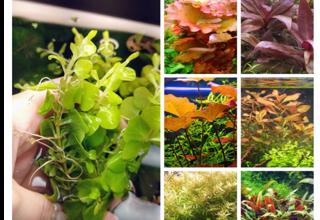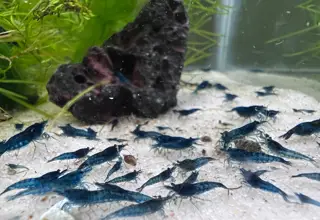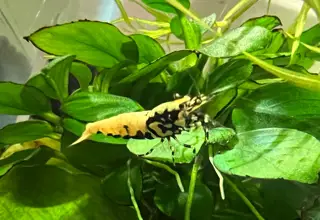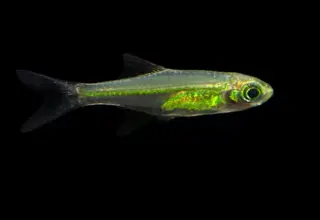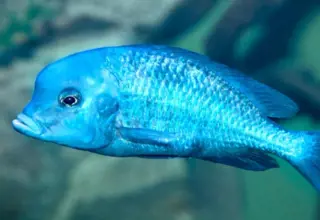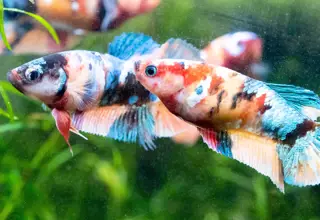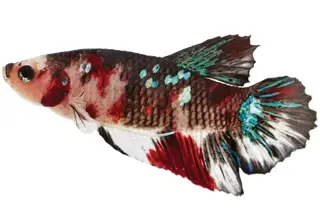Pygmy Sunfish: Care, Appearance & Types, Diet & More
Posted by on 03/09/2023
We use affiliate links and may receive a small commission on purchases.
When it comes to nano fish, chances are you've already heard of some of the more popular species. Tetras, guppies, and mollies frequently steal the spotlight, but there are many other fascinating species that have distinct appearances and personalities.
One example are Pygmy Sunfish. Only seven species comprise the genus, and these fish are highly sought after by those who are aware of their existence. In this post, we'll compare the different types of pygmy sunfish, and we'll discuss the care, diet, and tank requirements for this genus of fish.
Table of Contents
Species Summary
Pygmy Sunfish (genus: Elassoma) is a freshwater genus of fish that hails from the southeastern United States, where they live in streams, swamps, ponds, and other areas with heavy vegetation. These fish prefer slow-moving, shallow environments, where they live a solitary lifestyle.
Their scientific genus name, Elassoma, is a combination of the Greek words elasson and soma, which translates to "small body". A name that was given to the genus due to these sunfish being significantly smaller than the more well-known freshwater sunfish .
Pygmy sunfish were first scientifically classified in the 1800s, with Elassoma zonatum being the first by Stanford ichthyologist, David Starr Jordan .

Appearance & Types
Pygmy sunfish are sexually dimorphic fish, meaning there are differences in appearance between genders. Males will typically display iridescent blue markings, while females will display different shades of brown and beige throughout their bodies.
While it can be difficult to spot the differences between the different types of pygmy sunfish, there are some subtle differences to look for when determining species type.
Spring Pygmy Sunfish
The Spring Pygmy Sunfish (scientific name: Elassoma alabamae) can be found in northern Alabama, swimming in the Beaverdam Creek and the Blackwell Swamp.
Unfortunately, the species is nearly extinct and has been designated Critically Endangered by the IUCN . It's believed that the cause of their near extinction is due to declining water quality and quantity. Due to their designation, hobbyists should wait until there is a healthy population size in the wild. Luckily, thanks to the U.S. Fish & Wildlife Service, conservation efforts are underway, and many are now being kept in conservation fisheries.

Carolina Pygmy Sunfish
The Carolina Pygmy Sunfish (scientific name: Elassoma boehlkei) is native to the Waccamaw and Santee Rivers which stretch throughout North and South Carolina. These fish can be found in the aquarium trade, and it's no surprise as to why. The species has a set of iridescent vertical bars that span the fish's body and features an upturned mouth similar to that of a betta fish.
The species population has a vulnerable designation by the IUCN, but can still be found living in creeks and the wetlands of the Carolinas, where it survives primarily off of a diet consisting of micro crustaceans.

Everglades Pygmy Sunfish
Out of all the different types of pygmy sunfish, no species is more popular than the Everglades pygmy (scientific name: Elassoma evergladei). This fish can be found in the Cape Fear River and the naturally occurring marshes of central Florida.
Hobbyists appreciate the fish for its mating behavior and unique appearance. While there is some variation between individual fish, males that are ready to breed will typically have dark-colored bodies, adorned with iridescent blue spots. Females will exhibit an all-brown coloration, with little to no markings.

Gulf Coast Pygmy Sunfish
Hobbyists looking to catch a glimpse of the Gulf Coast Pygmy Sunfish (scientific name: Elassoma gilberti) in its natural habitat, should visit Georgia's Suwannee River, and the Florida Panhandle's Choctawhatchee Bay.
The Gulf Coast Pygmy is one of the smallest of all the pygmy sunfish, only growing to about an inch in length. Males from this species are quite attractive fish, sporting a black-colored body, with iridescent blue markings on their dorsal, anal, pelvic, and caudal fins. Additional blue markings can be found underneath their eyelids, rounding out their impressive appearance.

Bluebarred Pygmy Sunfish
The Bluebarred Pygmy Sunfish (scientific name: Elassoma okatie) can be found in the slow-moving drainage waters of the Savannah River, which borders Georgia and South Carolina. The Bluebarred Pygmy is slightly larger than the Gulf Coast pygmy, with adults topping out at around 1.3 inches in length.
As you may have guessed, the species is named after the vertical blue bars that stretch across the body of the males. While there is some variation in color between individual fish, the body of the Bluebarred pygmy is typically a lighter gray compared to the Gulf Coast Pygmy.

Okefenokee Pygmy Sunfish
The Okefenokee Swamp, a 438,000-acre wetland along the Florida-Georgia border is the home to a variety of different species including alligators, toads, frogs, herons, and, as you may have guessed - the Okefenokee Pygmy Sunfish.
Unlike the other pygmy sunfish, Okefenokee (scientific name: Elassoma okefenokee) sunfish have an olive green coloration but will transition to a blacker coloration when ready to mate. Hobbyists looking to distinguish the Okefenokee Pygmy from the Bluebarred Pygmy Sunfish should look to the anal fins, as the Okefenokee pygmy will have eight fin rays compared to the Bluebarred's seven.

Banded Pygmy Sunfish
Last on our list of Pygmy Sunfish is the Banded Pygmy (scientific name: Elassoma zonatum). The species has a widespread distribution, native to the slow-moving waters found between Texas and the Atlantic Coast. It's the largest of all the pygmy sunfish. When provided a well-balanced diet, adults can grow to be about 2 inches in length.
Banded Pygmies have perhaps the most unique appearance compared to the other species of pygmy sunfish. Both males and females have brown-colored bodies, with vertical black bands. Colors are more pronounced in the males, which feature bodies covered in small black dots that extend throughout their dorsal, caudal, anal, and pelvic fins.

Pygmy Sunfish Care
If you're interested in caring for a pygmy sunfish, it's important to have a good understanding of its care requirements. While these fish make an excellent choice for a nano aquarium, they are more difficult to care for than other nano fish species, largely due to their dietary requirements.
Luckily, these fish are well-documented and have been successfully raised in captivity for decades.
Lifespan
Pygmy Sunfish are short-lived fish and have an average lifespan of about a year and a half.
Lifespans are species-dependent. The Everglades Pygmy Sunfish typically averages a 1-year lifespan, while the Banded Pygmy averages a 3-year lifespan. The remaining species are typically somewhere in between.
As with all fish, a nutrient-rich diet combined with pristine water conditions will improve the chances that these fish will live a full and healthy life.
Tank Size
Due to their small size, Pygmy Sunfish make an excellent choice for hobbyists looking for a rare and unique-looking species to showcase in a nano tank. Aim for 1-2 species of pygmy sunfish for every 5 gallons of water.
The only exception would be if you decide on the Banded Pygmy Sunfish. Since this species tends to grow a bit larger (about 2.5 inches) you'll want to have at least a 10-gallon aquarium before adding 1-2 fish of this species.
Water Conditions
In the wild, these fish live in pH-neutral waters but are excellent at adapting to most tank conditions. As long as proper drip acclimation is followed, these fish can live comfortably and are even capable of spawning in a pH range between 6.5-7.5.
You'll want to recreate the following for any of the pygmy sunfish species:
Temperature Range: 70°F-80°F
pH: 6.5-7.5
KH: 3-10 dKH
These fish can live with or without a heater and are capable of doing well in water conditions that exceed the above-recommended ranges, but the above ranges can be used as a guideline.
Tank Setup
Pygmy Sunfish live in temperate, slow-moving waters in the swamplands of the southeastern United States.
The most important thing you'll want to include in a pygmy sunfish aquarium is plenty of live plants. The sky's the limit when it comes to planting options, java moss or flame moss, dwarf hairgrass, taiwan lilies, hygro, and even more demanding plants like rotala rotundifolia make excellent options in a pygmy sunfish aquarium.
Gravel-based substrates such as fluval's stratum or bio-stratum work well, and while we recommend a heater for hobbyists interested in breeding these fish, it's not a requirement for keeping any of the pygmy sunfish species.
When it comes to filtration, any HOB (hang-on-back) or canister filter rated for your tank size should be all that's needed. Avoid adding any additional powerheads, as these fish will prefer an area to rest that's out of your tank's current.
Common Diseases
When fully acclimated to their environment, Pygmy Sunfish are a relatively hardy species. As long as water conditions are monitored with a testing kit and bi-weekly 30% water changes are performed, it's unlikely that you'll encounter many diseases.
However, it's not impossible, and if a newly infected species is introduced into an aquarium with pygmy sunfish, they're still vulnerable to transmissible diseases such as ich and epistylis.
It's always best practice to quarantine any new fish in an established tank for a few weeks before introducing them into your display tank.
Food & Diet
Pygmy sunfish have unique dietary requirements and you'll want to feed them a diet consisting of black worms, bloodworms, and grindal worms 1-2 times per day over a 2-3 minute period.
In the wild, they feed off of microcrustaceans and small insect larvae, so it's not surprising that they require similar foods when kept in captivity.
Providing an optimal diet will give your fish the best chance at fending off diseases, and will aid in helping them reach their full life expectancy.
Behavior and Temperament
Pygmy Sunfish are a pretty laid-back genus of fish. Most of the time they can be found hovering in place along the substrate, or lounging near some of the foliage in their tanks.
However, their most interesting behavior is on full display when males are ready to spawn. These fish will flutter their tails and wiggle their bodies to attract a potential mate. Their ritualistic dance is unique to the genus, and it's fascinating to watch in a home aquarium.
These fish will also go through a color change. Males will transition from a more translucent to opaque coloration when they're ready to breed.
Overall, they're quite peaceful, males may establish small territories when they're looking to breed, but will rarely attack other males, even ones that encroach on their territories.
Tank Mates
Since pygmy sunfish have such a peaceful temperament, they can co-exist with other similarly sized fish that are also known to be peaceful.
Potential tank mate options include purple moscow guppies, cardinal tetras, and many of the more well-known peaceful schooling fish. Smaller pleco species, such as the green phantom pleco can work well with pygmy sunfish provided a large enough aquarium.
Consider avoiding snails such as black mysteries, and Neocaridina shrimp color morphs like the Orange Pumpkin. While pygmy sunfish can co-exist with these inhabitants, they may pick at any small invertebrates that are present in the aquarium. Both pygmy sunfish and invertebrates may also compete for the same food sources, which adds a layer of difficulty considering spring pygmies have unique dietary needs.
Additional male pygmies can be added to a pygmy sunfish aquarium, but once again - make sure that there is plenty of available foliage. If a male regularly sees a dominant male, it will lose its intense coloration. Having plenty of foliage and hiding spots will result in multiple dominant males, which hobbyists often prefer since the males will showcase their best coloration.
Breeding
Hobbyists looking to breed pygmy sunfish will enjoy knowing that they'll easily breed in captivity. Many aquarists recommend breeding these fish regularly. Due to their short lifespan, you can sustain your pygmy sunfish by continuously breeding the species.
Before you try and initiate the breeding process, you'll need to find a male and female of the same species. The only exceptions are everglade pygmy sunfish and banded pygmy sunfish, which have successfully been crossbred.
It's relatively easy to find a male/female pair since males will have the iridescent blue coloration with dark-colored bodies, while females will typically be beige and brown.
The breeding process for these fish is fairly straightforward. They'll show breeding behavior after they're a few months old and well-fed. You can encourage breeding by slowly increasing your tank temperature to about 77°F
You can breed these fish directly in your display tank if they're the only inhabitants, otherwise, you'll want to transition these fish to a breeding tank so that you can properly raise the fry. Once a spawning site is chosen by the fish, the female will lay eggs which will then be guarded by the male. Once hatched, you can begin to feed the fry small bits of baby brine shrimp. The fry are extremely delicate and require pristine tank conditions. You'll want to perform a 20% water change at least once a week. After a few weeks, you can begin to transition the pygmy sunfish fry to their adult diet.
Where To Purchase
Pygmy sunfish can be a difficult species to find for sale. We recommend visiting our marketplace or phoning up your local fish store.
Jonah's aquariums, who can be found on Facebook , is also a known vendor of these fish.
In Conclusion
Pygmy sunfish are rare and attractive looking nano fish. While they can be difficult to acquire, they reward hobbyists with their fascinating appearance and unique mating rituals.
Now that you've learned all about the different species of pygmy sunfish, do you plan on adding a few to your freshwater aquarium? Let us know by commenting below, and be sure to visit our marketplace and community forum, where you can buy, sell, and trade with other aquarium hobbyists.
